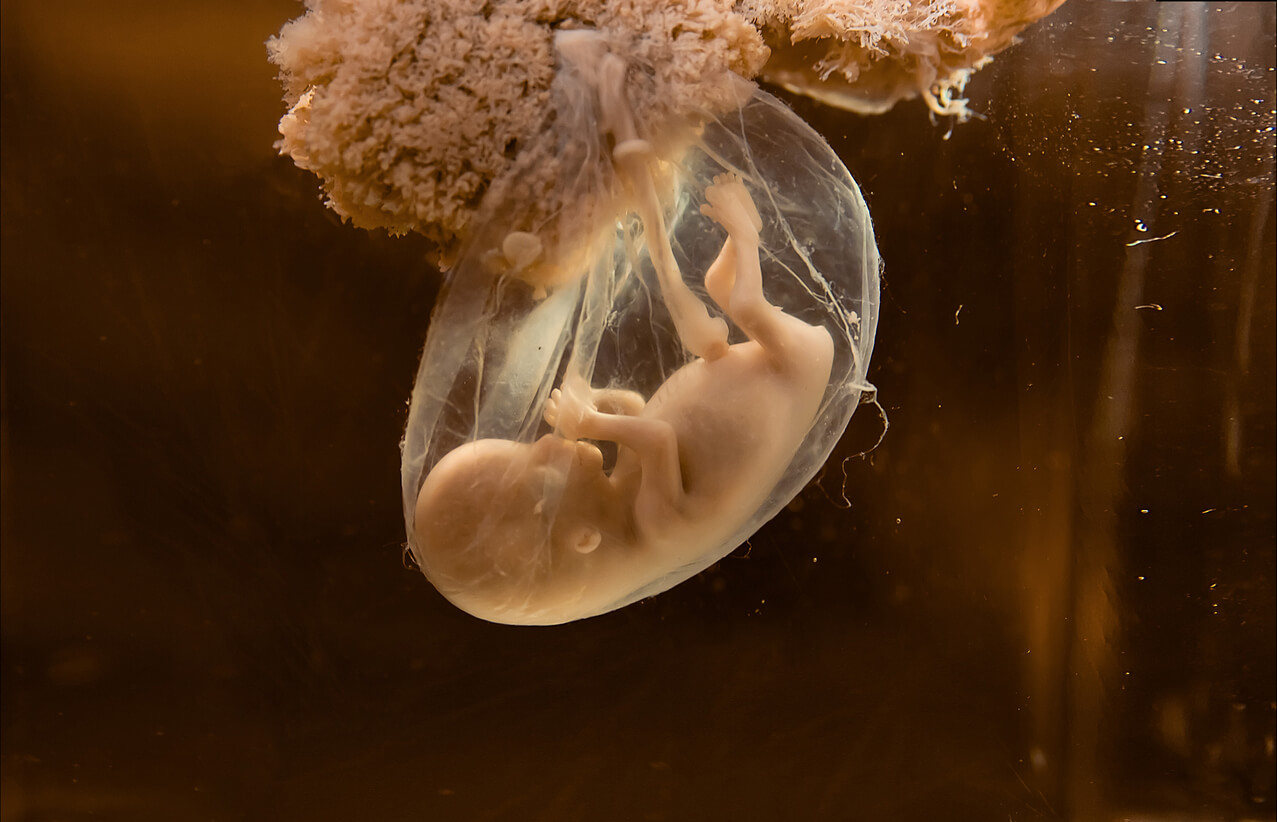How to Know if Your Water Broke? 8 Clues


Written and verified by the nurse Leidy Mora Molina
Pregnancy is a stage full of new experiences, as well as concerns about what will happen next and how the manifestations of childbirth will be identified. If you’re pregnant right now, you may be worried about how to know if your water broke. This is a very frequent question.
How do I know if my water broke? Below, we’ll bring you 8 clues with which you can guide yourself when this happens.
1. Did my water break?
When we talk about water breaking, we’re referring to the rupture of the amniotic sac or amniorrhexis, which is the membrane that covers the baby inside the womb. When a pregnancy reaches full term, its walls become thinner, and due to the pressure generated inside the sac, it ends up tearing and the liquid contained in it comes out through the vagina.
This manifestation is usually one of the markers of the onset of labor in many women. Contractions usually appear spontaneously after a few hours.
Although you may think that, when the water breaks, a large jet of liquid will come out, as this is what we often see in the movies and on television. However, this isn’t exactly how it happens in real life. You may notice an uncomfortable sensation due to an increase in the humidity of the vagina, due to the constant and slow loss of amniotic fluid. This fluid is watery, clear, and odorless.
It’s worth mentioning that not all women’s water breaks before the start of their labor. Some arrive at the hospital with several centimeters of dilation and with the membrane intact. In these cases, the specialist will assess the need to tear manually or let the process occur naturally.
2. Is it amniotic fluid or urine?
It’s quite common for some involuntary loss of urine to occur in the last days of pregnancy, as the enlarged uterus presses on the bladder. This can cause you some confusion when identifying which fluid is the one that’s causing your underwear to become wet.
The first differences between the two are odor and color: Amniotic fluid is odorless and clear, while urine is yellowish and has a characteristic ammonia odor.
Another way to distinguish liquids is through Kegel exercises. For this, you must keep your pelvic floor muscles contracted. If it’s urine, the leak will stop, but if it’s amniotic fluid, it won’t.

3. In what week will my water break?
Normally, the amniotic sac breaks from the 37th week of gestation, when the pregnancy has reached term and the baby is ready to be born. Now, if this happens before, it’s called premature rupture of the membranes.
In this case, the baby is probably not ready to leave the womb yet. Therefore, this is considered an emergency that requires prompt evaluation by a specialist.
4. What color will the liquid be if my water broke?
Amniotic fluid is clear, transparent, and odorless. At the beginning of the rupture, the amniotic fluid can be accompanied by the mucous plug, a gelatinous and pink secretion, with some strands of blood. Then, the liquid usually has the appearance of water.
Although unlikely, if the amniotic fluid turns red, yellow, green, or brown and has a foul odor, you should go to the hospital as soon as possible. This could indicate some complication in your health and that of your baby.
5. Drop by drop or as a stream?
Normally, when this sac breaks, the loss of amniotic fluid is in the form of a slow and constant drip. In general, it will start to wet your underwear to the point that you’ll have to change it several times.
In some cases, if the rupture of the membranes is larger, the mother may feel a slight snap and then have the sensation that a warm liquid comes out of her vagina and runs down her legs without being able to stop it. Keep in mind that the amount of amniotic fluid around week 37 is around 800 ml, which will come out gradually when this bag is torn.
The amount of amniotic fluid that comes out of the vagina can also be influenced by the position of the mother. This is because the baby can put pressure on the area where the rupture is with his head and thus regulate the flow of fluid.
6. Will I feel pain when my water breaks?
The membranes of the amniotic sac don’t have nerve endings, so this process is painless. Now, if the sac breaks while you’re also experiencing contractions, you’ll experience pain, but it will be due to another cause.
7. Are there contractions when my water breaks?
You won’t necessarily experience contractions when your water breaks and this depends on the moment in which it occurs (before or after the onset of labor). For this reason, many women who are hospitalized for having broken water, end up having their labor induced.
Most often, when contractions begin, the pressure to which the uterus is subjected causes the sac to break spontaneously and release the liquid contained within it.
8. How can I be sure my water broke?
If you suspect that your water broke and you’re in the last weeks of pregnancy, then you should go to the hospital to make sure that this actually happened. However, there’s no rush!
If the liquid is transparent, odorless, and you’re 37 weeks or older, you can take this symptom calmly and go to the health center after a few hours, as your baby will take a few more hours to arrive. Don’t forget to write down the time when your water broke, because this is a piece of information that your doctor or midwife may ask you for.
On the other hand, if this event occurs before week 37, or if the liquid has abnormal characteristics (red, yellow, greenish color or an unpleasant smell), you shouldn’t wait and you should go to the hospital as soon as possible.

So, if your water broke and everything’s going well, keep calm! After your water breaks and the contractions start, it usually takes a few hours before you finally meet your baby. Of course, if you’ve had previous deliveries, this process may be faster than the previous one.
It’s best to be prepared for this moment, so ask for recommendations from your doctor or midwife about what you should do and when to go to the health center.
Pregnancy is a stage full of new experiences, as well as concerns about what will happen next and how the manifestations of childbirth will be identified. If you’re pregnant right now, you may be worried about how to know if your water broke. This is a very frequent question.
How do I know if my water broke? Below, we’ll bring you 8 clues with which you can guide yourself when this happens.
1. Did my water break?
When we talk about water breaking, we’re referring to the rupture of the amniotic sac or amniorrhexis, which is the membrane that covers the baby inside the womb. When a pregnancy reaches full term, its walls become thinner, and due to the pressure generated inside the sac, it ends up tearing and the liquid contained in it comes out through the vagina.
This manifestation is usually one of the markers of the onset of labor in many women. Contractions usually appear spontaneously after a few hours.
Although you may think that, when the water breaks, a large jet of liquid will come out, as this is what we often see in the movies and on television. However, this isn’t exactly how it happens in real life. You may notice an uncomfortable sensation due to an increase in the humidity of the vagina, due to the constant and slow loss of amniotic fluid. This fluid is watery, clear, and odorless.
It’s worth mentioning that not all women’s water breaks before the start of their labor. Some arrive at the hospital with several centimeters of dilation and with the membrane intact. In these cases, the specialist will assess the need to tear manually or let the process occur naturally.
2. Is it amniotic fluid or urine?
It’s quite common for some involuntary loss of urine to occur in the last days of pregnancy, as the enlarged uterus presses on the bladder. This can cause you some confusion when identifying which fluid is the one that’s causing your underwear to become wet.
The first differences between the two are odor and color: Amniotic fluid is odorless and clear, while urine is yellowish and has a characteristic ammonia odor.
Another way to distinguish liquids is through Kegel exercises. For this, you must keep your pelvic floor muscles contracted. If it’s urine, the leak will stop, but if it’s amniotic fluid, it won’t.

3. In what week will my water break?
Normally, the amniotic sac breaks from the 37th week of gestation, when the pregnancy has reached term and the baby is ready to be born. Now, if this happens before, it’s called premature rupture of the membranes.
In this case, the baby is probably not ready to leave the womb yet. Therefore, this is considered an emergency that requires prompt evaluation by a specialist.
4. What color will the liquid be if my water broke?
Amniotic fluid is clear, transparent, and odorless. At the beginning of the rupture, the amniotic fluid can be accompanied by the mucous plug, a gelatinous and pink secretion, with some strands of blood. Then, the liquid usually has the appearance of water.
Although unlikely, if the amniotic fluid turns red, yellow, green, or brown and has a foul odor, you should go to the hospital as soon as possible. This could indicate some complication in your health and that of your baby.
5. Drop by drop or as a stream?
Normally, when this sac breaks, the loss of amniotic fluid is in the form of a slow and constant drip. In general, it will start to wet your underwear to the point that you’ll have to change it several times.
In some cases, if the rupture of the membranes is larger, the mother may feel a slight snap and then have the sensation that a warm liquid comes out of her vagina and runs down her legs without being able to stop it. Keep in mind that the amount of amniotic fluid around week 37 is around 800 ml, which will come out gradually when this bag is torn.
The amount of amniotic fluid that comes out of the vagina can also be influenced by the position of the mother. This is because the baby can put pressure on the area where the rupture is with his head and thus regulate the flow of fluid.
6. Will I feel pain when my water breaks?
The membranes of the amniotic sac don’t have nerve endings, so this process is painless. Now, if the sac breaks while you’re also experiencing contractions, you’ll experience pain, but it will be due to another cause.
7. Are there contractions when my water breaks?
You won’t necessarily experience contractions when your water breaks and this depends on the moment in which it occurs (before or after the onset of labor). For this reason, many women who are hospitalized for having broken water, end up having their labor induced.
Most often, when contractions begin, the pressure to which the uterus is subjected causes the sac to break spontaneously and release the liquid contained within it.
8. How can I be sure my water broke?
If you suspect that your water broke and you’re in the last weeks of pregnancy, then you should go to the hospital to make sure that this actually happened. However, there’s no rush!
If the liquid is transparent, odorless, and you’re 37 weeks or older, you can take this symptom calmly and go to the health center after a few hours, as your baby will take a few more hours to arrive. Don’t forget to write down the time when your water broke, because this is a piece of information that your doctor or midwife may ask you for.
On the other hand, if this event occurs before week 37, or if the liquid has abnormal characteristics (red, yellow, greenish color or an unpleasant smell), you shouldn’t wait and you should go to the hospital as soon as possible.

So, if your water broke and everything’s going well, keep calm! After your water breaks and the contractions start, it usually takes a few hours before you finally meet your baby. Of course, if you’ve had previous deliveries, this process may be faster than the previous one.
It’s best to be prepared for this moment, so ask for recommendations from your doctor or midwife about what you should do and when to go to the health center.
All cited sources were thoroughly reviewed by our team to ensure their quality, reliability, currency, and validity. The bibliography of this article was considered reliable and of academic or scientific accuracy.
- Association of Ontario Midwives (2020). Cuando rompe aguas antes del trabajo de parto. Recuperado de: https://www.ontariomidwives.ca/sites/default/files/2020-06/When-your-water-breaks-before-labour-Spanish.pdf
- Lopez, F. (2006). Ruptura prematura de membranas fetales: de la fisiopatología hacia los marcadores tempranos de la enfermedad. Revista Colombiana de Obstetricia y Ginecología Vol. 57 No. 4 • 2006 • (279-290). Recuperado de: http://www.scielo.org.co/pdf/rcog/v57n4/v57n4a07.pdf
- Mayo Clinic (2021). Ruptura de la fuente: conoce esta señal del trabajo de parto. Recuperado de: https://www.mayoclinic.org/es-es/healthy-lifestyle/labor-and-delivery/in-depth/water-breaking/art-20044142
- Morgan, F. et al (2015). Anatomía y fisiología de la placenta y líquido amniótico. Revista Médica UAS; Vol. 5: No. 4. Recuperado de: http://hospital.uas.edu.mx/revmeduas/pdf/v5/n4/amniotico.pdf
This text is provided for informational purposes only and does not replace consultation with a professional. If in doubt, consult your specialist.








